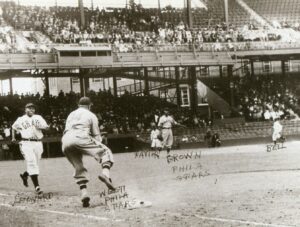In 1920 the Negro National League was formed by Andrew “Rube” Foster, a former player and manager for various teams. Taking advantage of the growth of the Black Northern urban populations during and following World War I, and insisting on Black ownership of the teams, Foster lead a group of team owners to create the Negro National League (NNL) in Kansas City, Missouri on February 14, 1920. The league initially had eight teams: The Chicago American Giants, the Chicago Giants, the Cuban Stars (New York), the Dayton (Ohio) Marcos, the Detroit Stars, the Indianapolis ABC’s, the Kansas City Monarchs, and the St. Louis Giants. The NNL was soon followed in 1923 by a rival league, the Eastern Colored League. Between 1924 and 1927 the two leagues met in a world series but the onset of the Great Depression in 1929 forced both leagues to fold. Teams emerged in the South as well including the Memphis Red Sox, the Birmingham Black Barons, the Atlanta Black Crackers, and the Jacksonville Red Caps.

Black professional baseball, however, continued. Between 1931 and 1937 a number of teams were formed and then disbanded. The only survivors were the teams in the new Negro National League which operated from 1933 to 1936. Black players competed abroad often on teams in Mexico, Cuba, the Dominican Republic, and Venezuela
In 1937, two regional leagues were formed, the Negro American League in the East and the reformulated Negro National League in the West. Beginning in 1937 the winners of each league met in a world series of Black baseball. These leagues continued during World War II, but in late 1945 Jackie Robinson, who had played one season with the Kansas City Monarchs in the Negro Leagues, signed a contract with the Brooklyn Dodgers organization. By 1947, after a year in the minor league, Robinson became the first Black player in Major League Baseball since 1888. After Robinson signed with the Dodgers, other (white) major league teams began signing many of the stars of the Black baseball leagues. By the end of 1950, most of the Black professional baseball leagues had disbanded although the Indianapolis Clowns, the inspiration for the 1976 film, The Bingo Long Traveling All Stars & Motor Kings, continued playing until 1989. In all, approximately 3,400 players were part of the seven leagues operating between 1920 and 1950.
American All-Stars, 1945 on Tour in Caracas, Venezuela. Jackie Robinson, Far Left Front Row, Roy Campanella, Second From Left, Back RowDuring this centennial year, 2020, BlackPast is dedicating this page to the memory of the Negro National League and the other leagues that became Black professional baseball in the early decades of the 20th Century. We have assembled below profiles of many of the star players, the teams, and the owners. We have also added the names of often-overlooked women professional baseball players of that era. If there are players, teams, or African American owners not linked here please let us know at [email protected].
Minidoc: The Negro Baseball Leagues
Black Players in Major League Baseball, 1878-1888
Players, 1920-1989 (Men)
- Hank Aaron
- James “Cool Papa” Bell
- Roy Campanella
- Oscar Charleston
- Ray Emmitt Dandridge
- Herbert Alphonso “Rap” Dixon
- Larry Doby
- Andrew “Rube” Foster
- Joshua “Josh” Gibson
- John Preston “Pete” Hill
- Monford Merrill Monte Irvin
- William Julius “Judy” Johnson
- Walter Fenner “Buck” Leonard
- John Henry “Pop” Lloyd
- John Jordan “Buck” O’Neil
- Leroy Robert “Satchel” Paige
- Richard “Cannonball Dick” Redding
- Jackie Robinson
- Charles Wilber “Bullet” Rogan
- Hilton Lee Smith
- Norman Thomas “Turkey” Stearnes
- George “Mule” Suttles
- Reece “Goose” Tatum
- Willie James Wells
- “Smokey” Joe Williams
Players, 1920-1989 (Women)
Teams, 1920-1989
- The Atlanta Black Crackers
- The Bacharach Giants
- Nashville/ Baltimore Elite Giants
- The Birmingham Black Barons
- Brooklyn Royal Giants
- Chicago American Giants
- The Cleveland Buckeyes
- Detroit Stars
- The Hilldale Athletic Club/ Hilldale Daisies
- Homestead Grays
- The Indianapolis ABCs
- The Indianapolis Clowns
- The Jacksonville Red Caps
- The Kansas City Monarchs
- The Lincoln Giants
- The Memphis Red Sox
- The Newark Eagles
- The New York Black Yankees
- The Pittsburgh Crawfords
- The Seattle Royal Giants
- The Seattle Steelheads
- St. Louis Stars/ St. Louis Giants
Owners, 1920-1989
Through a special arrangement with the National Bobblehead Hall of Fame and Museum in Milwaukee, Wisconsin, BlackPast.org is pleased to offer for sale bobbleheads of the major Negro Leagues players. Proceeds from the sale of these bobbleheads go to the families of the players, the National Baseball League Museum in Kansas City, Missouri, and BlackPast. Click here to see all of the bobbleheads on BlackPast.


